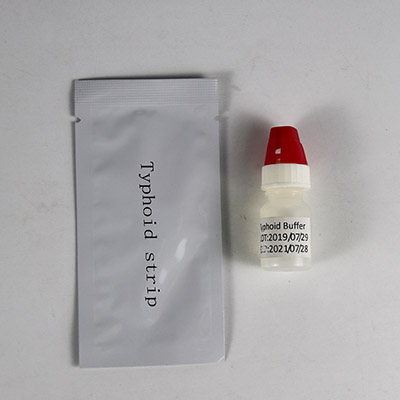heTyphoid IgG/IgM Rapid Test is a rapid chromatographic immu
-noassay for the qualitative detection of antibodies (IgG and IgM) to Salmonella typ hi in Whole Blood /Serum / Plasma to aid in the diagnosis of Salmonella typhi infec tion.
Summary
Typhoid fever is a bacterial disease, caused by Salmonella typhi. It is transmitted through the ingestion of food or drink contaminated by the faeces or urine of infected people. Symptoms usually develop 1–3 weeks after exposure, and may be mild or severe. They include high fever, malaise, headache, constipation or diarrhoea, rose-coloured spots on the chest, and enlarged spleen and liver. Healthy carrier state may follow acute illness. One step Typhoid IgG/IgM Test is a simple, visual qualitative test that detects Typhoid antibodies in human Whole Blood/serum/plasma. The test is based on immunochromatography and can give a result within 15 minutes.
The Typhoid IgG/IgM Test is a qualitative membrane strip based immunoassay for the detection of Typhoid antibodies (IgG and IgM) in Whole Blood /Serum / Plasma. The test device consists of: 1) a burgundy colored conjugate pad containing Typhoid recombinant envelope antigens conjugated with Colloid gold (Typhoid conjugates) and rabbit IgG-gold conjugates,2) a nitrocellulose membrane strip containing two test bands (T1 and T2 bands) and a control band (C band). The T1 band is pre-coated with the antibody for the detection of IgG anti-Typhoid, T2 band is coated with antibody for the detection of IgM anti-Typhoid, and the C band is pre-coated with goat anti rabbit IgG. When an adequate volume of test specimen is dispensed into the sample well of the test cassette, the specimen migrates by capillary action across the cassette. IgM anti-Typhoid, if present in the specimen, will bind to the Typhoid conjugates. The immunocomplex is then captured by the reagent pre-coated on the T2 band, forming a burgundy colored T2 band, indicating a Typhoid IgM positive test result and suggesting a fresh infection. IgG anti-Typhoid if present in the specimen will bind to the Typhoid conjugates. The immunocomplex is then captured by the reagent coated on the T1 band, forming a burgundy colored T1 band, indicating a Typhoid IgG positive test result and suggesting a recent or repeat infection. Absence of any T bands (T1 and T2) suggests a negative result. The test contains an internal control (C band) which should exhibit a burgundy colored band of the immunocomplex of goat anti rabbit IgG/rabbit IgG-gold conjugate regardless of the color development on any of the T bands. Otherwise, the test result is invalid and the specimen must be retested with another device.
Warnings and Precautions
For in vitro diagnostic use only.
For healthcare professionals and professionals at point of caresites.
Do not use after the expiration date.
Please read all the information in this leaflet before performing the test.
The test panel should remain in the sealed pouch untiluse.
All specimens should be considered potentially hazardous and handled in the same manner as an infectious agent.
The used test panel should be discarded according to federal, state and local regulations.
and Mouse anti-Human IgG antibody on the test line, Goat anti rabbit IgG on the control line, and a dye pad which contains colloidal gold coupled with Typhoid recombinant envelope antigens and Rabbit IgG.
Each box contains test panels and package insert.
Materials required but not provided: Specimen collection container, Timer.
Storage and Stability
Store as packaged in the sealed pouch at room temperature (2-30℃ or 36-86 ℉).The kit is stable within the expiration date printed on the labeling.
Once open the pouch, the test should be used within one hour. Prolonged exposure to hot and humid environment will cause productdeterioration.
Specimen
The test can be used to test Whole Blood / Serum/Plasmaspecimens.
To collect whole blood, serum or plasma specimens following regular clinical laboratory procedures.
Separate serum or plasma from blood as soon as possible to avoid hemolysis. Use only clear non-hemolyzed specimens.
Store specimens at 2-8℃(36-46℉) if not tested immediately. Store specimens at 2-8℃ up to 7 days. The specimens should be frozen at -20℃(-4℉) for longer storage. Do not freeze whole blood specimens.
Avoid multiple freeze-thaw cycles. Prior to testing, bring frozen specimens to room temperature slowly and mix gently. Specimens containing visible particulate matter should be clarified by centrifugation beforetesting.
Do not use samples demonstrating gross lipemia, gross hemolysis or turbidity in order to avoid interference on resultinterpretation.
Test Procedure
Allow the test device and specimens to equilibrate to room temperature (15-30℃or 59-86℉) prior to testing.
1.Bring the pouch to room temperature before opening it. Remove the test device from the sealed pouch and use it as soon aspossible.
2.Place the test device on a clean and level surface.
3.Hold the dropper vertically and transfer 1 drop of specimen (approximately 35μl) to the specimen well(S) of the test device, then add 2 drops of buffer (approximately 70μl) and start the timer. See illustrationbelow.
4.Wait for the colored line(s) to appear. Read results at 15 minutes. Do not interpret the result after 20 minutes.
bio-equip.cn




